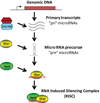miRNA in pluripotent stem cells
- PMID: 20632858
- PMCID: PMC3077715
- DOI: 10.2217/rme.10.34
miRNA in pluripotent stem cells
Abstract
Embryonic stem cells and induced pluripotent stem cells are characterized by their ability to self-renew and differentiate into any cell type. The molecular mechanism behind this process is a complex interplay between the transcriptional factors with epigenetic regulators and signaling pathways. miRNAs are an integral part of this regulatory network, with essential roles in pluripotent maintenance, proliferation and differentiation. miRNAs are a class of small noncoding RNAs that target protein-encoding mRNA to inhibit translation and protein synthesis. Discovered close to 20 years ago, miRNAs have rapidly emerged as key regulatory molecules in several critical cellular processes across species. Recent studies have begun to clarify the specific role of miRNA in regulatory circuitries that control self-renewal and pluripotency of both embryonic stem cells and induced pluripotent stem cells. These advances suggest a critical role for miRNAs in the process of reprogramming somatic cells to pluripotent cells.
Figures




Similar articles
-
Noncoding RNAs in the Regulation of Pluripotency and Reprogramming.Stem Cell Rev Rep. 2018 Feb;14(1):58-70. doi: 10.1007/s12015-017-9782-9. Stem Cell Rev Rep. 2018. PMID: 29143182 Review.
-
Emerging roles of microRNAs in the control of embryonic stem cells and the generation of induced pluripotent stem cells.Dev Biol. 2010 Aug 1;344(1):16-25. doi: 10.1016/j.ydbio.2010.05.014. Epub 2010 May 15. Dev Biol. 2010. PMID: 20478297 Free PMC article. Review.
-
Embryonic stem cell microRNAs: defining factors in induced pluripotent (iPS) and cancer (CSC) stem cells?Curr Stem Cell Res Ther. 2009 Sep;4(3):168-77. doi: 10.2174/157488809789057400. Curr Stem Cell Res Ther. 2009. PMID: 19492978 Review.
-
MicroRNAs in pluripotency, reprogramming and cell fate induction.Biochim Biophys Acta. 2013 Aug;1833(8):1894-903. doi: 10.1016/j.bbamcr.2013.03.025. Epub 2013 Apr 1. Biochim Biophys Acta. 2013. PMID: 23557785 Review.
-
[The effect of microRNAs on the regulatory network of pluripotency in embryonic stem cells].Yi Chuan. 2013 Oct;35(10):1153-66. doi: 10.3724/sp.j.1005.2013.01153. Yi Chuan. 2013. PMID: 24459889 Review. Chinese.
Cited by
-
Advances in RNA Viral Vector Technology to Reprogram Somatic Cells: The Paramyxovirus Wave.Mol Diagn Ther. 2022 Jul;26(4):353-367. doi: 10.1007/s40291-022-00599-x. Epub 2022 Jun 28. Mol Diagn Ther. 2022. PMID: 35763161 Review.
-
Current methods and challenges in the comprehensive characterization of human pluripotent stem cells.Stem Cell Rev Rep. 2015 Apr;11(2):357-72. doi: 10.1007/s12015-014-9580-6. Stem Cell Rev Rep. 2015. PMID: 25504379 Review.
-
miRNome Profiling of Purified Endoderm and Mesoderm Differentiated from hESCs Reveals Functions of miR-483-3p and miR-1263 for Cell-Fate Decisions.Stem Cell Reports. 2017 Nov 14;9(5):1588-1603. doi: 10.1016/j.stemcr.2017.10.011. Stem Cell Reports. 2017. PMID: 29141233 Free PMC article.
-
Mir-302 cluster exhibits tumor suppressor properties on human unrestricted somatic stem cells.Tumour Biol. 2014 Jul;35(7):6657-64. doi: 10.1007/s13277-014-1844-x. Epub 2014 Apr 5. Tumour Biol. 2014. PMID: 24705778
-
MicroRNAs: a new piece in the paediatric cardiovascular disease puzzle.Cardiol Young. 2013 Oct;23(5):642-55. doi: 10.1017/S1047951113000048. Epub 2013 Feb 26. Cardiol Young. 2013. PMID: 23443043 Free PMC article. Review.
References
-
- Thomson JA, Itskovitz-Eldor J, Shapiro SS, et al. Embryonic stem cell lines derived from human blastocysts. Science (New York, N.Y. 1998;282(5391):1145–1147. - PubMed
-
- Choumerianou DM, Dimitriou H, Kalmanti M. Stem cells: Promises versus limitations. Tissue engineering. 2008;14(1):53–60. - PubMed
-
- Aoi T, Yae K, Nakagawa M, et al. Generation of pluripotent stem cells from adult mouse liver and stomach cells. Science (New York, N.Y. 2008;321(5889):699–702. - PubMed
-
- Takahashi K, Okita K, Nakagawa M, Yamanaka S. Induction of pluripotent stem cells from fibroblast cultures. Nature protocols. 2007;2(12):3081–3089. - PubMed
-
- Takahashi K, Tanabe K, Ohnuki M, et al. Induction of pluripotent stem cells from adult human fibroblasts by defined factors. Cell. 2007;131(5):861–872. - PubMed
Publication types
MeSH terms
Substances
Grants and funding
LinkOut - more resources
Full Text Sources
